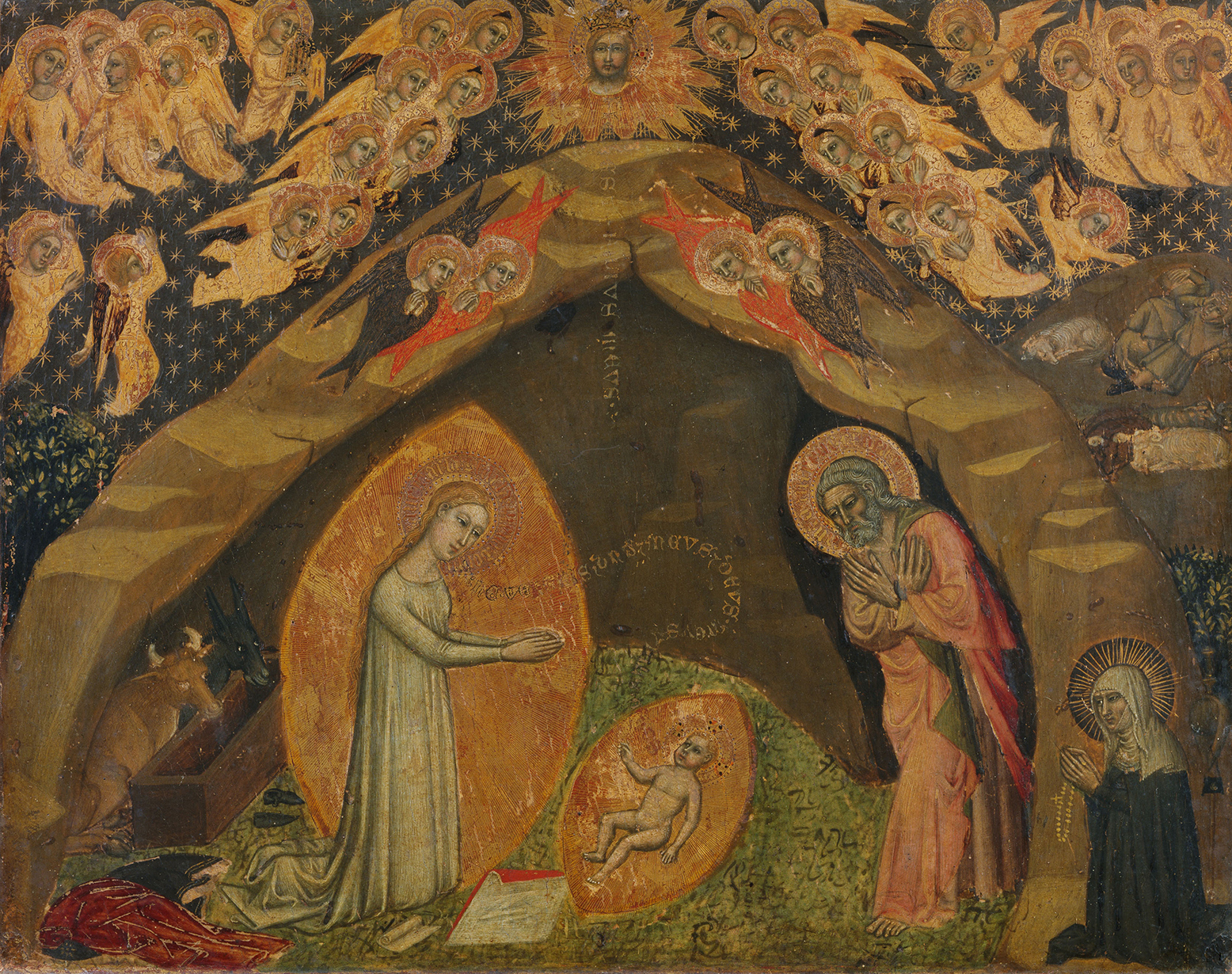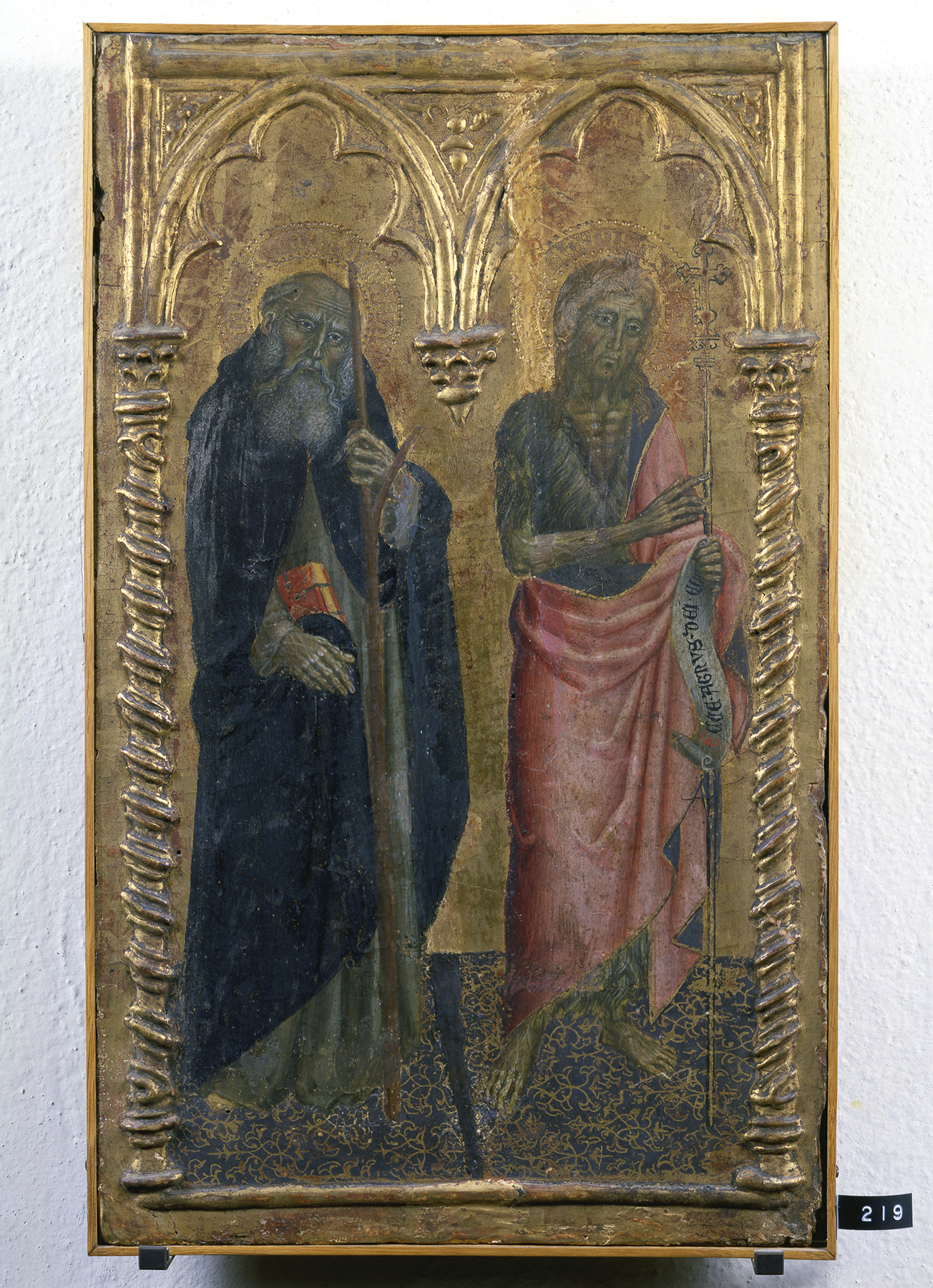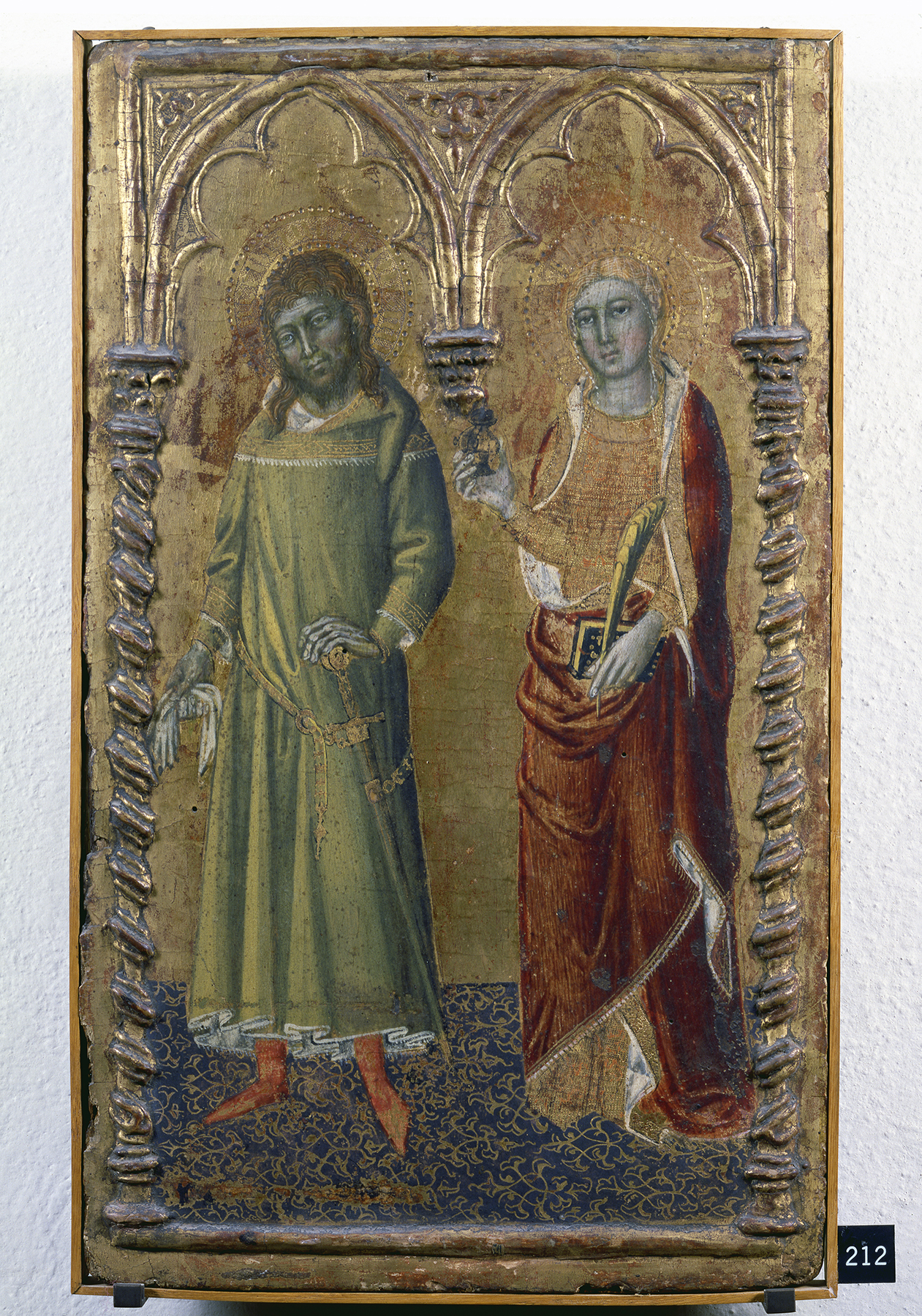in the Virgin’s halo, AVE MARIA GRATIA; in Saint Joseph’s halo, SANCTUS IOSEP; against the ground above the Christ Child, presumably following what was once a banderole, [ . . . ] VS DEVS MEVS [DOMINUS?] FILLI [ . . . ]
Arthur Acton (1873–1953), Florence; Maitland Fuller Griggs (1872–1943), New York, by 1926
The panel support, which retains its original thickness of 3.4 centimeters, has evidently been trimmed along the right and top edges but may preserve nearly its original extent at the left and bottom edges. The gilding and paint surface have been severely abraded, even obliterated in broad areas, while total losses of color and gesso along the left edge and to the right of Saint Joseph’s head have exposed the linen underlayer. The absence of linen beneath total losses at the top left and right corners may indicate that these areas were once covered by frame moldings and therefore that the panel was once surmounted by a gable, but evidence for such a reconstruction is inconclusive. No evidence of missing hinges is apparent at either the left or right edge.
The composition, to the extent that it can still be discerned in the painting’s present state, follows closely the description by Saint Bridget of Sweden (1302–1373) of her miraculous vision of the Nativity, which occurred on March 13, 1372, while she was in Bethlehem on a pilgrimage to the Holy Land. The Virgin, dressed only in a white chemise, kneels at the left in the mouth of a cave or grotto, her discarded red robe and blue mantle lying on the ground beneath her and her shoes placed neatly behind her at the left. Her hands are joined in prayer, and her head is bowed as she adores the newborn Christ Child lying naked on the ground before her. Both the Virgin and the Child are surrounded by mandorlas of light. Beneath the Child is a large square of white cloth with its edge turned up, and between Him and His mother is a smaller rolled cloth. These were described by Saint Bridget as having been brought by the Virgin and placed by her on the ground, in anticipation of dressing her baby. Saint Joseph, in a pink or, more likely, violet robe, stands in a dark recess at the right, his hands crossed before his breast in humility. Further to the right, the diminutive figure of Saint Bridget, in a black habit and white veil, kneels outside the mouth of the cave, her pilgrim’s staff cropped at the edge of the panel and a rayed nimbus around her head. The ox and ass traditionally present in scenes of the Nativity kneel in the center of the picture field, presumably tied to a now-obliterated manger. A chorus of seven angels hovering at the top of the cave opening forms an arch above the heads of the holy figures. They, too, join their hands in prayer as they sing the praises of the Virgin and Christ Child. Outside the cave at the upper right is a fragmentary scene of the Annunciation to the Shepherds. The balancing scene at the upper left is illegible. Several inscriptions are still partially legible on the panel.
Three closely related illustrations of the mystical vision of Saint Bridget survive that are conventionally attributed to Niccolò di Tommaso: the present panel, the center panel of a gabled triptych in the Philadelphia Museum of Art, and a rectangular panel in the Pinacoteca Vaticana. These differ only slightly from one another. The composition of the Philadelphia version (fig. 1) is markedly more vertical than the other two. In it, two seraphs and two cherubs hover at the mouth of the cave, a chorus of angels fills the gold ground outside of the cave, and God the Father blesses the scene from above. Inscriptions on it are more numerous and more descriptive than on the Yale panel, and certain details follow the narrative of Saint Bridget’s vision more closely. The ox and ass, for example, are shown behind the Virgin’s back, as specifically described by Saint Bridget, and the candle left by Saint Joseph—the light of which was eclipsed by the “ineffable light and splendor” radiating from the Christ Child—is mounted on the back wall of the cave.


All these details, except the candle, are present in the version in the Pinacoteca Vaticana (fig. 2), which takes advantage of its more horizontal format to add a vignette of the Annunciation to the Shepherds over the brow of the hill at the right. The Yale panel retains (or originates?) the vignette of the Annunciation to the Shepherds outside the cave: the hands of the annunciatory angel are cropped at the top edge of the panel, implying the loss of a considerable area of paint surface there. Presumably, God the Father was also originally included above the scene, as was, in all likelihood, a more extensive choir of angels. The seraphim and cherubim attending the vision in Philadelphia and the Vatican are replaced here by seven angels, and the ox and ass are moved to the center of the composition—the ox portrayed in very sophisticated foreshortening with the vertebrae of its spine prominently outlined along its back. Saint Joseph’s candle, if it was ever present, is no longer to be found, but the saint himself is more accurately segregated from the scene by a low wall of rock dividing him from the Virgin and Child: Bridget described him as having gone outside, “so that he might not be present at the birth.” Portrayed in this manner, he seems to follow Bridget’s description of him entering after the Virgin pronounced her benediction, “Be welcome my God, my Lord and my Son.”
It must be assumed that all three of these paintings postdate Saint Bridget’s return to Naples from the Holy Land in February 1373, and it is logical to adduce the probable date of Niccolò di Tommaso’s death, 1376, as a terminus ante quem, although Millard Meiss suggested dating them between 1375 and 1385.1 Erling Skaug introduced further evidence to reduce by one year the probable period of their execution, to 1373–75.2 All three panels break from the standard decorative practice of Niccolò di Tommaso’s work through the conspicuous absence of any of the punch tools that the artist shared with a number of his Florentine contemporaries. In the Yale panel, Niccolò employed a rotella—an extremely rare practice among panel painters—with six parallel rows of simple pointed teeth, most clearly visible in the wings of the angels hovering above the mouth of the cave. Skaug reasonably presumed that these discrepancies imply that the panels were executed not in Florence but in Naples (or hypothetically in Rome), before Niccolò’s return to Tuscany in late 1375. Although he did not accept Skaug’s conclusions in full, Carl Strehlke agreed that the Philadelphia triptych may have been painted in Naples, arguing further that it may have been commissioned by one of Bridget’s patrons, Nicola Orsini, and that it could have been the prime version of the composition.3 The Vatican panel is notably coarser than the painting in Philadelphia, reducing all of the carefully observed spatial relationships in the latter to a flat, schematic arrangement and introducing crude exaggerations of proportion and technique in rendering the figures as well as an implausibly decorative night sky diapered with stars instead of a gold ground. It is likely that this painting is the work of a Neapolitan, or possibly Roman, artist, either in Niccolò di Tommaso’s studio or copying or interpreting an image by him.


The Yale panel is—or was—painted at a level of quality and inventive originality at least equal to that of the Philadelphia panel, although the minor iconographic changes it introduces suggests that it is unlikely to have preceded the latter in ideation. It is not clear what function it might originally have been intended to serve or what its precise format might have been. It has been reduced in height and modestly in width, but it cannot be ascertained whether it was once gabled or was always rectangular. Skaug proposed, tentatively, that two panels in the Pinacoteca Vaticana representing Saints Anthony Abbot and John the Baptist (fig. 3) and Saints Julian and Lucy (fig. 4), sometimes thought to have been the wings of a triptych with the Vatican Vision of Saint Bridget at its center, might instead have been associated with the Yale panel.4 This proposal was based on a loose correspondence of dimensions and on the common use within all three of the unusual rotella punch. The Yale panel, however, is exceptionally thick for the center panel of a portable triptych and shows no visible evidence of the removal of hinges at either side. Hinges might have been driven into now-missing frame moldings surrounding the image, but for no hinge scars to be in evidence on the reverse of the panel such moldings would have to have been large enough to alter the panel’s proportions significantly, making association with the Vatican wings even less likely.
It may be assumed that numerous images of Saint Bridget were created during the process of her canonization. In the postscript to a letter from Bridget’s confessor and the prime mover of her beatification and canonization, Alfonso Pecha di Jaén, Bridget’s daughter Karin Ulfsdottir stated that many images of her mother were to be found in Italian churches and that the pope even kept one in his bedchamber.5 In addition to more conventional hagiographic imagery, this passage might also have been meant to refer to scenes of the mystical vision of the Nativity such as this one, where a “portrait” of the kneeling Bridget is included at the right. Whatever the interpretation of Karin Ulfsdottir’s postscript, the majority of the paintings she mentions must have been relatively small, as they were sent to influential patrons in various European centers. So few survive, however, that no conclusions about them as a group, who made them, when, or where, can be advanced with confidence. —LK
Published References
Meiss, Millard. Painting in Florence and Siena after the Black Death: The Arts, Religion, and Society in the Mid-Fourteenth Century. Princeton, N.J.: Princeton University Press, 1951., 149–50n73; Offner, Richard. “A Ray of Light on Giovanni del Biondo and Niccolò di Tommaso.” Mitteilungen des Kunsthistorischen Institutes in Florenz 7, nos. 3–4 (July 1956): 173–92., 191; Berenson, Bernard. Italian Pictures of the Renaissance, A List of the Principal Artists and Their Works with an Index of Places: The Florentine School. 2 vols. London: Phaidon, 1963., 1:162; Seymour, Charles, Jr. Early Italian Paintings in the Yale University Art Gallery. New Haven: Yale University Art Gallery, 1970., 66, no. 45; Fredericksen, Burton B., and Federico Zeri. Census of Pre-Nineteenth-Century Italian Paintings in North American Public Collections. Cambridge, Mass.: Harvard University Press, 1972., 600; Boskovits, Miklós. Pittura fiorentina alla vigilia del Rinascimento, 1370–1400. Florence: Edam, 1975., 203n108; Offner, Richard. A Critical and Historical Corpus of Florentine Painting: The Fourteenth Century. Supplement: A Legacy of Attributions. Ed. Hayden B. J. Maginnis. New York: Institute of Fine Arts, New York University, 1981., 90; Offner, Richard. A Critical and Historical Corpus of Florentine Painting. Sec. 3, vol. 2, Elder Contemporaries of Bernardo Daddi. Ed. Miklós Boskovits. Florence: Giunti, 1987., 110n13; Volbach, Wolfgag Fritz. Catalogo della Pinacoteca Vaticana. Vol. 2, Il trecento: Firenze e Siena. Vatican City: Libreria Editrice Vaticana, 1987., 26; Skaug, Erling S. “St. Bridget’s Vision of the Nativity and Niccolò di Tommaso’s Late Period.” Arte cristiana 89, no. 804 (2001): 195–209., 202; Skaug, Erling S. “Niccolò di Tommaso of Florence, Saint Bridget of Sweden’s First Painter.” Acta ad archaeologiam et artium historiam pertinentia 18, no. 4 (2004): 289–321., 290, 290n2, 304, 304n34, 305, 308, 311, 311n45, 312–13, figs. 3, 6, 18; Strehlke, Carl Brandon. Italian Paintings, 1250–1450, in the John G. Johnson Collection and the Philadelphia Museum of Art. Philadelphia: Philadelphia Museum of Art, 2004., 345
Notes
-
Meiss, Millard. Painting in Florence and Siena after the Black Death: The Arts, Religion, and Society in the Mid-Fourteenth Century. Princeton, N.J.: Princeton University Press, 1951., 149–50n73. ↩︎
-
Skaug, Erling S. “St. Bridget’s Vision of the Nativity and Niccolò di Tommaso’s Late Period.” Arte cristiana 89, no. 804 (2001): 195–209., 202; and Skaug, Erling S. “Niccolò di Tommaso of Florence, Saint Bridget of Sweden’s First Painter.” Acta ad archaeologiam et artium historiam pertinentia 18, no. 4 (2004): 289–321.. ↩︎
-
Strehlke, Carl Brandon. Italian Paintings, 1250–1450, in the John G. Johnson Collection and the Philadelphia Museum of Art. Philadelphia: Philadelphia Museum of Art, 2004., 345. ↩︎
-
Skaug, Erling S. “St. Bridget’s Vision of the Nativity and Niccolò di Tommaso’s Late Period.” Arte cristiana 89, no. 804 (2001): 195–209., 202. ↩︎
-
Nordenfalk, Carl. “Saint Bridget of Sweden as Represented in Illuminated Manuscripts.” In Essays in Honor of Erwin Panofsky, ed. Millard Meiss, 1:371–94. De Artibus Opuscula 40. New York: New York University Press, 1961., 1:379–81. ↩︎